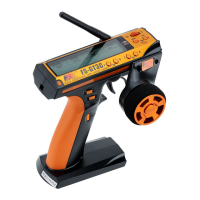
Do you have a question about the Fly Sky FS-GT3C and is the answer not in the manual?
| Channels | 3 |
|---|---|
| Frequency | 2.4GHz |
| Modulation | GFSK |
| Power | 100mW |
| Low Voltage Warning | Yes |
| DSC Port | Yes |
Introduction to the 2.4G ratio remote control digital products.
Information on obtaining help and support for product issues.
Explains manual symbols and provides essential safety guidelines for operation.
Lists technical specifications of the 2.4GHz AFHDS system.
Describes key characteristics like multi-frequency hopping and high sensitivity.
Instructions for charging the transmitter via DC power or computer USB.
Procedures for charging the transmitter with a charger and the receiver.
Detailed specifications for the FS-GT3C transmitter.
Detailed specifications for the FS-GR3C receiver.
Guide for connecting the receiver when a motor controller is used.
Installation guide for gas-powered RC models.
General notes and procedures for operating the 2.4G system.
Steps for pairing the transmitter and receiver (code matching).
Correct procedures for powering on and shutting down the system.
Detailed explanation of the transmitter's LCD display interface.
Describes the initial screen and the function of each transmitter button.
How to set up and manage different model memories on the transmitter.
Function for assigning names to model memories for easier identification.
How to reverse servo direction for steering, throttle, and channel 3.
Adjusts servo endpoint travel for steering, throttle, and channel 3.
Adjusts the neutral position of servos for steering, throttle, and channel 3.
Sets Dual Rate to limit the total travel of each channel.
Adjusts the sensitivity of steering servo response around the neutral position.
Configures the Auto Brake System (ABS) function for the throttle channel.
How to control steering and adjust dual rates using the D/R knob.
How to control throttle speed for acceleration and braking.